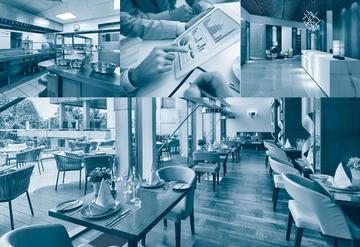How to Master Lease Analysis for the Hospitality Industry

Hospitality Lease Analysis
In the world of hospitality, where every detail can influence a guest's experience, the properties you operate in hold
significant sway. From the luxurious expanse of a hotel lobby to the cozy nook of a boutique B&B, understanding
hospitality lease analysis is of paramount importance. As the industry aims to provide unparalleled experiences while
ensuring profitability, diving deep into the intricacies of leasing becomes essential. Let's embark on this journey,
ensuring your hospitality enterprise shines in the best light.
1. Hospitality Spaces: Crafting First
Impressions
The properties in the hospitality sector aren't just functional spaces; they're the very
essence of the guest experience. By optimizing leases, hoteliers and operators can:
- Secure prime locations to enhance guest appeal.
- Balance rent with potential revenue streams.
- Facilitate scalability for brand expansion.
- Ensure proximity to popular attractions or business hubs.
2. Types of Hospitality Leases: Curating the Perfect Fit
- Gross Lease: Operators pay a lump sum rent, with the landlord covering most property costs.
- Net Lease: Where tenants handle the base rent and specific property-related expenses.
- Percentage Lease: Ideal for establishments with fluctuating incomes, where rent is a base amount plus a percentage of monthly revenue.
3. Key Terminologies in Hospitality Lease Analysis
- CAM Fees (Common Area Maintenance): Costs associated with the maintenance of shared spaces in establishments like malls or multi-unit buildings.
- Rent Abatements: Periods where rent may be reduced or entirely waived, often at the start of the lease.
- Leasehold Improvements: Modifications made to the leased space to enhance guest experience.
- Option to Renew: A clause allowing the operator to extend the lease under predetermined conditions.
4. Integrating ASC 842 into Lease Analysis
The adoption of ASC 842 lease accounting
standards necessitates hospitality entities to bring most leases onto their balance sheets. This move towards
transparent financial reporting is pivotal, and hospitality businesses must ensure they weave these standards into their
lease analysis framework.
5. Beyond the Luxe Interiors: Strategic Implications
Beyond the
financial considerations, operators should factor in:
- The ease of revamping spaces to align with changing design trends.
- Proximity to transportation hubs for guest convenience.
- The flexibility of the lease in accommodating operational changes.
- Market dynamics, including emerging travel trends and regional tourism fluctuations.
Evaluating a hospitality lease, such as for a hotel, restaurant, or resort, requires a specific set of financial metrics that cater to the unique nuances of the hospitality industry.
Key financial metrics to consider when evaluating a hospitality lease:
1. Rent per Square Foot:
This
metric allows you to gauge the cost of the lease relative to the space's size, helping in comparisons with other
potential leasing opportunities.
2. Percentage Rent:
In addition to a base rent, many hospitality leases
include a percentage rent clause where the landlord receives a percentage of the business's sales or revenue. This can
significantly impact the overall cost of the lease.
3. Total Cost of Lease:
It encompasses all
lease-related costs over its term, including base rent, percentage rent, common area maintenance fees, and any other
additional charges.
4. Lease Duration and Renewal Terms:
Understanding the length of the lease and the
terms for renewal can provide clarity on long-term occupancy costs and potential rent escalations.
5. Break-Even
Analysis:
This metric helps determine the sales volume or occupancy rate required to cover all lease-related
costs. It's crucial for forecasting and financial planning.
6. Occupancy Cost Ratio:
This ratio compares
the total leasing costs to the generated revenue. A high ratio might indicate that the lease is relatively expensive for
the income it helps produce.
7. Capital Expenditure Requirements:
Any costs associated with initial setup,
renovations, or mandatory upgrades should be factored into the lease evaluation.
8. Termination and Renewal
Clauses:
Understanding the implications, costs, and benefits associated with early lease termination or renewal
can influence long-term financial planning.
9. Net Present Value (NPV) and Internal Rate of Return
(IRR):
These metrics assess the lease's financial viability over its term by considering future cash flows and
the time value of money.
10. Tax Implications:
Different lease structures can have varying tax
implications, including potential benefits such as deductions for lease payments or depreciation.
11. Market
Benchmarking:
Comparing the lease terms, costs, and other associated fees with market benchmarks can provide
insights into whether the lease is competitively priced.
12. Contingency Clauses:
Given the cyclical
nature of the hospitality industry, it's crucial to understand any clauses in the lease that address downturns in
business, such as rent abatements or deferred payments.
In the hospitality sector, where location, ambiance, and
space play a pivotal role in success, understanding and evaluating these financial metrics is paramount. Properly
assessing a hospitality lease ensures that the establishment is positioned not just for operational success, but also
for financial sustainability and growth.
Hospitality Lease Analysis is more than a financial
endeavor; it's the foundation upon which memorable guest experiences are built. As travel and hospitality trends evolve,
being adept in your leasing decisions ensures you're always in vogue, resonating with travelers' aspirations.
Navigating ASC 842 in Lease Analysis
An essential aspect that stakeholders in leasing — whether it’s commercial real estate, equipment, fleet vehicles, or oil & gas — must consider is the ASC 842 lease accounting standard. Implemented by the Financial Accounting Standards Board (FASB), ASC 842 necessitates organizations to recognize leases on their balance sheets, bringing transparency to previously off-balance sheet leasing activities. This standard has a profound impact on financial reporting and requires lessees to recognize assets and liabilities for most leases. As you embark on your leasing journey, ensuring compliance with ASC 842 not only safeguards against potential financial discrepancies but also fortifies your organization’s credibility in financial disclosures. Partnering with iLeasePro can streamline this process, ensuring that your lease analysis is both strategic and compliant.



